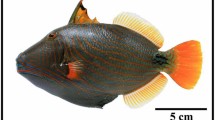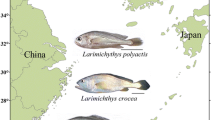Abstract
Two geographically distant populations of Chironomus riparius (syn. C. thummi) from two environmentally polluted sites (Santena, Italy and Varna, Bulgaria) show numerous somatic and inherited chromosomal aberrations (inversions, deletions and deficiencies). Fifty-five percent of the observed breakpoints occurred in at least two larvae from both populations. Breakpoints occurring twice or more were considered as ‘common’ structural chromosomal breakpoints. We tested whether such common breakpoints in larvae of the two polluted populations had a random chromosomal distribution or occurred preferentially in specific heterochromatic regions. Distribution of common breakpoints was not random, and proximal regions of first and third chromosome had significantly more common breakpoints than distal ones. By FISH we identified and mapped 56 chromosomal sections containing clusters of two tandem-repetitive satellite DNA families called Hinf and Alu elements. Like the common breakpoints, these repetitive DNA clusters appeared to be significantly more abundant in regions of constitutive heterochromatin such as the pericentromeric regions, while in distal sections of chromosomal arms they were rare or absent. Twenty-four out of 45 common breakpoints (i.e., 53.3%) occurred in cytogenetic sections where Alu and Hinf satellite DNA probes hybridized. The frequency of co-localization between common breakpoints and repetitive DNA hybridization signals was significantly higher than expected by chance. We hypothesize that spontaneous or induced breaks occur more frequently in sections containing blocks of repetitive DNA.
Similar content being viewed by others
References
Blinov, A.G., Y.V. Sobanov, E.K. Gaidamakova, S.S. Bogachev, N.N. Kolesnikov, M.A. Filippova & I.I. Kiknadze, 1991. MEC: a transposable element from Chironomus thummi. Mol. Gen. Genet. 229: 152–154.
Blinov, A.G., Y.V. Sobanov, S.S. Bogachev, M.A. Filippova & A.P. Dochenko, 1993. Chironomus thummi genome contains a non-LTR retrotransposon. Mol. Gen. Genet. 237: 412–420.
Bovero, S., 1999. I cromosomi politenici di Chironomus riparius (Diptera: Chironomidae) come modello per lo studio della genotossicità. PhD Thesis. University of Torino, 107pp.
Caceres, M., A. Barbadilla & A. Ruiz, 1999. Recombination rate predicts inversion size in Diptera. Genetics 153: 251–259.
Cirera, S., J.M. Martin-Campos, C. Segarra & M. Aguadé, 1995. Molecular characterization of the breakpoints of an inversion fixed between Drosophila melanogaster and D. subobscura. Genetics 139: 321–326.
Coquelle, A., E. Pipiras, F. Toledo, G. Buttin & M. Debatisse, 1997. Expression of fragile sites triggers intrachromosomal mammalian gene amplification and sets boundaries to early amplicons. Cell 89: 215–225.
Dimitri, P., 1997. Constitutive heterochromatin and transposable elements in Drosophila melanogaster. Genetica 100: 85–93.
Gunderina, L.I. & K.G. Aimanova, 1998. Genetic consequences of exposure to γ-radiation in Chironomus thummi: aberrations of polytene chromosomes. Russ. J. Genet. 34: 273–280 (in Russian).
Hägele, K., 1975. Chironomus, pp. 269–278 in: Handbook of Genetics, Vol. 3, edited by R.C. King. Plenum Press, New York.
Hägele, K., 1984. Different hybrid effects in reciprocal crosses between Chironomus thummi and Chironomus th. piger including spontaneous chromosome aberrations and sterility. Genetica 63: 105–111.
Hankeln, T., 1990. Moleculare analyse phylogenetisch bedeutsamer repetitiver DNA bei Chironomiden. PhD Thesis. Rhur University, Bochum.
Hankeln, T., H.G. Keyl, R. Ross & E.R. Schmidt, 1993. Evolution of histone gene loci in chironomid midges. Genome 36: 852–862.
Hankeln, T., A. Rohwedder, B., Weich & E.R. Schmidt, 1994a. Transposition of minisatellite sequences during evolution of chironomid midges. Genome 37: 542–549.
Hankeln, T., M.A. Filippova, I.I. Kiknadze, K.G. Aimanova & E.R. Schmidt, 1994b. Centromeric heterochromatin and satellite DNA in the Chironomus plumosus species group. Genome 37: 925–934.
Hoogland, C., C. Vieira & C. Biemont, 1997. Chromosomal distribution of the 412 retrotransposon in natural populations of Drosophila simulans. Heredity 79: 128–134.
Janssens de Bisthoven, L., J.F. Postma, P. Parren, K. Timmermans & F. Ollevier, 1988. Relations between heavy metals in aquatic sediments and in Chironomus larvae of Belgian lowland rivers and their morphological deformities. Can. J. Fish Aquat. Sci. 55: 688–703.
Keyl, H.G., 1965. A demonstrable local and geometric increase in the chromosomal DNA of Chironomus. Experientia 21: 191–193.
Kiknadze, I.I., N.N. Kolesnikov, T.M. Panova, E.K. Gaidamakova, A.G. Blinov & A.M. Filippova, 1987. Transposable elements in Chironomidae: localization of pCthC12HR sequences in the polytene chromosomes of closely related subspecies C. th. thummi and C. th. piger and their hybrids. Genetika 23: 1366–1376 (in Russian).
Kiknadze, I.I., L. Gunderina, A.M. Filippova & E. Seray, 1988. Chromosomal polymorphism in natural and laboratory populations of Chironomus thummi Kieff. Genetika 24: 1795–1805 (in Russian).
Kiknadze, I.I., A. Shilova, I. Kerkis, N. Shobanov, N. Zelenzov, F. Grebenjuk, A. Istomina & B. Praslov, 1991. Karyotype and morphology of larvae in Chironomini. Atlas, Novosibirsk, 117pp.
Küntzel, G., K.I. Gecheff & I. Schubert, 2001. Different chromosomal distribution patterns of radiation-induced interchange breakpoints in barley: first post-treatment mitosis versus viable offspring. Genome 44: 128–132.
Michailova, P., 1989. The polytene chromosomes and their significance to the systematics of the family Chironomidae, Diptera. Acta Zool. Fennica 186: 1–107.
Michailova, P., N. Petrova, L. Ramella, G. Sella, J. Todorova & V. Zelano, 1996. Cytogenetic characteristics of a population of Chironomus riparius Meigen (1804) (Diptera, Chironomidae) from a polluted Po river station. Genetica 98: 161–178.
Michailova, P., N. Petrova, L. Ramella, G. Sella & S. Bovero, 1998. Structural and functional alterations of chromosome G of Chironomus riparius from a polluted Piedmont station. Environ. Pollut. 103: 127–134.
Michailova, P., N. Petrova, S. Bovero, O. Cavicchioli, L. Ramella & G. Sella, 2000. Effect of environmental pollution on the chromosome variability of Chironomus riparius Meigen (1804) (Diptera, Chironomidae) larvae from two Piedmont stations. Genetica 108: 171–180.
Mishmar, D., A. Rahat, S.W. Scherer, G. Nyakatura, B. Hinzmann, Y. Kohwi, H. Mandel-Inoue, H. Ishi, H. Alder, E. Snyder, T. Druck & K. Huebner, 1997. Sequence of the FRA3B common fragile region: implications for the mechanism of FHIT deletion. Proc. Nat. Acad. Sci. USA 94: 14,584–14,589.
Nuzhdin, S.V., 1995. The distribution of transposable elements on X chromosomes from a natural population of Drosophila simulans. Genet. Res. Camb. 66: 159–166.
Pleshkova, G.N., 1983. Distribution of breakpoints in radiation induced chromosomal rearrangements along the polytene chromosomes of Anopheles messae. Genetika 19: 1457–1462 (in Russian).
Richards, R.I., 2001. Fragile and unstable chromosomes in cancer: causes and consequences. Trends Genet. 17: 339–345.
Schaefer, J. & E.R. Schmidt, 1981. Different repetition frequencies of a 120 base-pair DNA-element and its arrangement in Chironomus thummi thummi and Chironomus piger. Chromosoma 84: 61–66.
Schmidt, E.R., 1984. Clustered and interspersed repetitive DNA sequence family of Chironomus. J. Mol. Biol. 178: 1–15.
Schmidt, E.R., 1992. Multicolor in situ hybridization-a helpful technique for precise gene localization. Sci. Tech. Inform. Serv. X(3): 80–84.
Sperry, A.O., V.C. Blasquez & W.T. Garrard, 1989. Disfunction of chromosomal loop attachment sites: illegitimate recombination linked to matrix association regions and topoisomerase II. Proc. Natl. Acad. Sci. USA 86: 5497–5501.
Spitzner, J.R., I.K. Chung & M.T. Muller, 1990. Eukaryotic topoisomerase II preferentially cleaves alternating purine-pyrimidine repeats. Nucleic Acids Res. 18: 1–12.
Stark, G.R., M. Debatisse, E. Giulotto & G.M. Whal, 1989. Recent progress in understanding mechanism of mammalian DNA amplification. Cell 57: 901–908.
Sutherland, G.R., E. Baker & R.I. Richards, 1998. Fragile sites still breaking. TIG 14: 501–506.
Todorova, J., 2000. Cytotaxonomic variability of Chironomus riparius Meigen (Diptera, Chironomidae) from anthropogenically influenced regions in Bulgaria. Acta Zool. Bulgarica 52(2): 13–24.
Tonzetich, J., T.W. Little & H.L. Carson, 1988. Induced and natural break sites in the chromosomes of the Hawaiian Drosophila. Proc. Natl. Acad. Sci. USA 85: 1717–1721.
Wesley, C.S. & F.W. Eanes, 1994. Isolation and analysis of the breakpoint sequences of chromosome inversion In(3L)Payne in Drosophila melanogaster. Proc. Natl. Acad. Sci. USA 91: 3132–3136.
William, K.A., D.W. Green, D. Pascoe & D. Gower, 1986. The acute toxicity of cadmium to different larval stages of Chironomus riparius (Diptera, Chironomidae) and its ecological significance for pollution regulation. Oecologia 70: 362–366.
Wobus, U., H. Baumlein, S.S. Bogachev, I.W. Borisevich, R. Panitz & N.N. Kolesnikov, 1990. A new transposable element in Chironomus thummi. Mol. Gen. Genet. 222: 311–316.
Yunis, Y. J. & A.L. Soreng, 1984. Constitutive fragile sites and cancer. Science 226: 1199–1204.
Zhimulev, I.F., 1998. Polytene chromosomes, heterochromatin and position effect variegation. Adv. Genet. 37: 202.
Zhimulev, I.F., V.F. Semeshin, V.A. Kulichkov & E.S. Belyaeva, 1982. Intercalary Heterochromatin in Drosophila. Chromosoma 87: 197–228.
Author information
Authors and Affiliations
Rights and permissions
About this article
Cite this article
Bovero, S., Hankeln, T., Michailova, P. et al. Nonrandom Chromosomal Distribution of Spontaneous Breakpoints and Satellite DNA Clusters in two Geographically Distant Populations of Chironomus Riparius (Diptera: Chironomidae). Genetica 115, 273–281 (2002). https://doi.org/10.1023/A:1020697228525
Issue Date:
DOI: https://doi.org/10.1023/A:1020697228525




